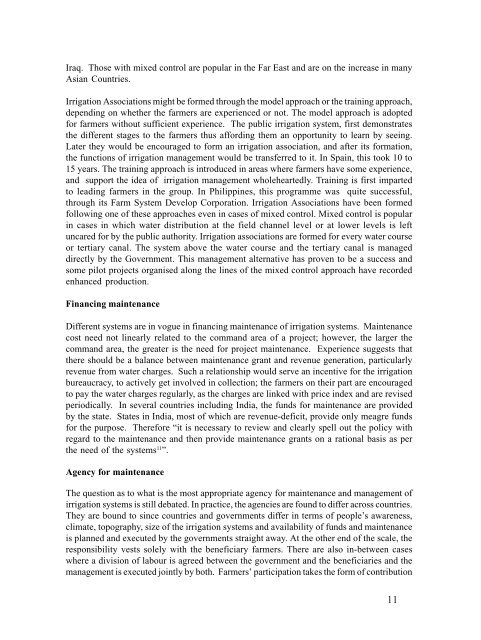Beneficiary Participation in Irrigation Water Management: The Kerala
Beneficiary Participation in Irrigation Water Management: The Kerala
Beneficiary Participation in Irrigation Water Management: The Kerala
Create successful ePaper yourself
Turn your PDF publications into a flip-book with our unique Google optimized e-Paper software.
Iraq. Those with mixed control are popular <strong>in</strong> the Far East and are on the <strong>in</strong>crease <strong>in</strong> many<br />
Asian Countries.<br />
<strong>Irrigation</strong> Associations might be formed through the model approach or the tra<strong>in</strong><strong>in</strong>g approach,<br />
depend<strong>in</strong>g on whether the farmers are experienced or not. <strong>The</strong> model approach is adopted<br />
for farmers without sufficient experience. <strong>The</strong> public irrigation system, first demonstrates<br />
the different stages to the farmers thus afford<strong>in</strong>g them an opportunity to learn by see<strong>in</strong>g.<br />
Later they would be encouraged to form an irrigation association, and after its formation,<br />
the functions of irrigation management would be transferred to it. In Spa<strong>in</strong>, this took 10 to<br />
15 years. <strong>The</strong> tra<strong>in</strong><strong>in</strong>g approach is <strong>in</strong>troduced <strong>in</strong> areas where farmers have some experience,<br />
and support the idea of irrigation management wholeheartedly. Tra<strong>in</strong><strong>in</strong>g is first imparted<br />
to lead<strong>in</strong>g farmers <strong>in</strong> the group. In Philipp<strong>in</strong>es, this programme was quite successful,<br />
through its Farm System Develop Corporation. <strong>Irrigation</strong> Associations have been formed<br />
follow<strong>in</strong>g one of these approaches even <strong>in</strong> cases of mixed control. Mixed control is popular<br />
<strong>in</strong> cases <strong>in</strong> which water distribution at the field channel level or at lower levels is left<br />
uncared for by the public authority. <strong>Irrigation</strong> associations are formed for every water course<br />
or tertiary canal. <strong>The</strong> system above the water course and the tertiary canal is managed<br />
directly by the Government. This management alternative has proven to be a success and<br />
some pilot projects organised along the l<strong>in</strong>es of the mixed control approach have recorded<br />
enhanced production.<br />
F<strong>in</strong>anc<strong>in</strong>g ma<strong>in</strong>tenance<br />
Different systems are <strong>in</strong> vogue <strong>in</strong> f<strong>in</strong>anc<strong>in</strong>g ma<strong>in</strong>tenance of irrigation systems. Ma<strong>in</strong>tenance<br />
cost need not l<strong>in</strong>early related to the command area of a project; however, the larger the<br />
command area, the greater is the need for project ma<strong>in</strong>tenance. Experience suggests that<br />
there should be a balance between ma<strong>in</strong>tenance grant and revenue generation, particularly<br />
revenue from water charges. Such a relationship would serve an <strong>in</strong>centive for the irrigation<br />
bureaucracy, to actively get <strong>in</strong>volved <strong>in</strong> collection; the farmers on their part are encouraged<br />
to pay the water charges regularly, as the charges are l<strong>in</strong>ked with price <strong>in</strong>dex and are revised<br />
periodically. In several countries <strong>in</strong>clud<strong>in</strong>g India, the funds for ma<strong>in</strong>tenance are provided<br />
by the state. States <strong>in</strong> India, most of which are revenue-deficit, provide only meagre funds<br />
for the purpose. <strong>The</strong>refore “it is necessary to review and clearly spell out the policy with<br />
regard to the ma<strong>in</strong>tenance and then provide ma<strong>in</strong>tenance grants on a rational basis as per<br />
the need of the systems 11 ”.<br />
Agency for ma<strong>in</strong>tenance<br />
<strong>The</strong> question as to what is the most appropriate agency for ma<strong>in</strong>tenance and management of<br />
irrigation systems is still debated. In practice, the agencies are found to differ across countries.<br />
<strong>The</strong>y are bound to s<strong>in</strong>ce countries and governments differ <strong>in</strong> terms of people’s awareness,<br />
climate, topography, size of the irrigation systems and availability of funds and ma<strong>in</strong>tenance<br />
is planned and executed by the governments straight away. At the other end of the scale, the<br />
responsibility vests solely with the beneficiary farmers. <strong>The</strong>re are also <strong>in</strong>-between cases<br />
where a division of labour is agreed between the government and the beneficiaries and the<br />
management is executed jo<strong>in</strong>tly by both. Farmers’ participation takes the form of contribution<br />
11










